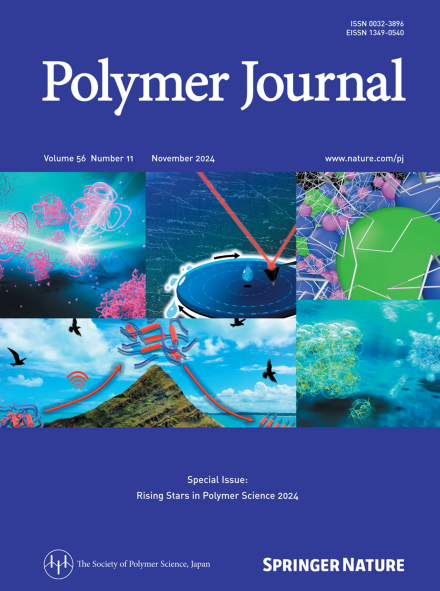A combined study on intermolecular interactions between polystyrene and d-limonene utilizing light-scattering experiments and computational simulations
IF 2.3
4区 化学
Q3 POLYMER SCIENCE
引用次数: 0
Abstract
To quantitatively evaluate the solvent quality of d-limonene for polystyrene, light-scattering experiments were performed on polystyrene in d-limonene. Molecular-level information on the intermolecular interactions between the repeat unit of polystyrene and d-limonene was obtained by means of computational simulations. From the light-scattering experiments, the mean-square radius of gyration 〈S2〉 values for atactic polystyrene (a-PS) with weight-average molecular weights ranging from 3.73 × 104 to 2.87 × 106 in d-limonene at 25.0 °C were determined to be between those in toluene, a good solvent, and those in cyclohexane, a poor solvent. Moreover, the second virial coefficient A2 values of a-PS in d-limonene were smaller than half of those in toluene. The 〈S2〉 and A2 values were analyzed according to the helical wormlike chain model, and the binary-cluster integral β, representing the magnitude of the excluded volume between constituent segments of a-PS, was found to exhibit an intermediate value between those in toluene and cyclohexane, confirming that d-limonene is a medium solvent for a-PS. The intermolecular interaction energy between cumene as a model compound representing the repeat unit of polystyrene and d-limonene, which was obtained from the computational simulations, supported the estimated solvent quality for polystyrene. The intermolecular interactions between polystyrene (PS) and d-limonene were comprehensively studied utilizing both light-scattering experiments and computational simulations. From analyses of the mean-square radius of gyration 〈S2〉 and second virial coefficient A2 for PS in d-limonene determined by the light-scattering experiments, d-limonene was confirmed as a medium solvent with intermediate solvent quality between good solvents like toluene and poor solvents like cyclohexane for PS. The intermolecular interaction energy between repeat unit of PS and d-limonene, which was obtained from the computational simulations, supported the estimated solvent quality for PS.

聚苯乙烯与d-柠檬烯分子间相互作用的光散射实验与计算模拟
为了定量评价d-柠檬烯对聚苯乙烯的溶剂质量,在d-柠檬烯中对聚苯乙烯进行了光散射实验。通过计算模拟,获得了聚苯乙烯重复单元与d-柠檬烯分子间相互作用的分子水平信息。通过光散射实验,确定了重均分子量为3.73 × 104 ~ 2.87 × 106的无规聚苯乙烯(a- ps)在25.0℃时在d-柠檬烯中的均方旋转半径< S2 >值介于良好溶剂甲苯和较差溶剂环己烷之间。d-柠檬烯中a-PS的第二维里系数A2小于甲苯的一半。根据螺旋虫状链模型分析了< S2 >和A2值,发现代表a- ps组成段之间排除体积大小的二元簇积分β值介于甲苯和环己烷之间,证实了d-柠檬烯是a- ps的介质溶剂。通过计算模拟得到了代表聚苯乙烯重复单元的模型化合物异丙烯与d-柠檬烯之间的分子间相互作用能,支持了聚苯乙烯溶剂质量的估计。采用光散射实验和计算模拟的方法,对聚苯乙烯(PS)与d-柠檬烯的分子间相互作用进行了全面研究。通过光散射实验对d-柠檬烯中PS的均方旋转半径< S2 >和二阶维里系数A2的分析,证实了d-柠檬烯是介于甲苯等良好溶剂和环己烷等不良溶剂之间的介质溶剂。通过计算模拟得到的PS与d-柠檬烯重复单元的分子间相互作用能支持了PS的溶剂质量估计。
本文章由计算机程序翻译,如有差异,请以英文原文为准。
求助全文
约1分钟内获得全文
求助全文
来源期刊

Polymer Journal
化学-高分子科学
CiteScore
5.60
自引率
7.10%
发文量
131
审稿时长
2.5 months
期刊介绍:
Polymer Journal promotes research from all aspects of polymer science from anywhere in the world and aims to provide an integrated platform for scientific communication that assists the advancement of polymer science and related fields. The journal publishes Original Articles, Notes, Short Communications and Reviews.
Subject areas and topics of particular interest within the journal''s scope include, but are not limited to, those listed below:
Polymer synthesis and reactions
Polymer structures
Physical properties of polymers
Polymer surface and interfaces
Functional polymers
Supramolecular polymers
Self-assembled materials
Biopolymers and bio-related polymer materials
Polymer engineering.
 求助内容:
求助内容: 应助结果提醒方式:
应助结果提醒方式:


